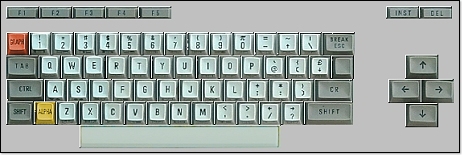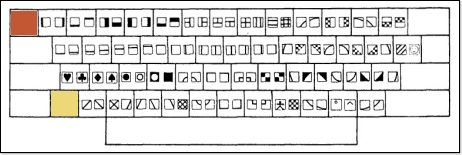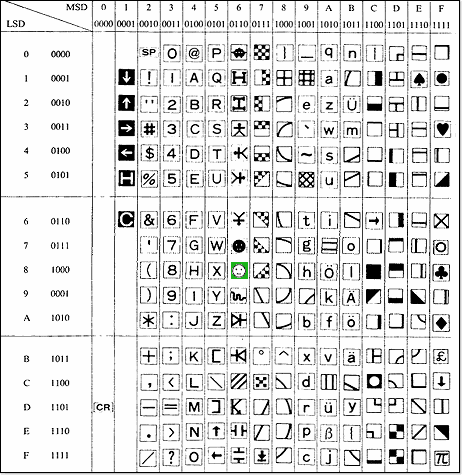Hardware: Keyboard
 Your MZ-800 has got a lot of special graphic characters, which are also accessible via keyboard. To type these chars, first press the “GRAPH” key on your keyboard to switch to graphic charset mode. Each key owns two graphic chars, which can be accessed now by pressing the appropiate key (or pressing “SHIFT” and the key). You can return to the standard charset by hitting the “ALPHA” key.
Your MZ-800 has got a lot of special graphic characters, which are also accessible via keyboard. To type these chars, first press the “GRAPH” key on your keyboard to switch to graphic charset mode. Each key owns two graphic chars, which can be accessed now by pressing the appropiate key (or pressing “SHIFT” and the key). You can return to the standard charset by hitting the “ALPHA” key.
The following tables show the graphic font table and their locations (as well as their hexadecimal codes) on the keyboard as shown in the MZ-800 operating manual.
 This is your MZ's keyboard. I have painted the “GRAPH” key red and the “ALPHA” key yellow, so that they are easier to find by MZ newbies :)
This is your MZ's keyboard. I have painted the “GRAPH” key red and the “ALPHA” key yellow, so that they are easier to find by MZ newbies :)
By the way, this image was taken from Zdenek Adlers MZ emulator, which provides a virtual keyboard (only one of tons of features!).
To find a graphic char, perform the following:
 Simply map the desired char's key position to the keyboard shown above to find out the appropiate key.
Simply map the desired char's key position to the keyboard shown above to find out the appropiate key.
Please note: In the second image, I omitted the cursor-, “INST”- and “DEL”-keys in order to gain space, otherwise the graphic chars would have been too small to recognize them.
 MSD is the abbreviation of the “most significant digits” of a byte, and LSD is not only a drug, but also the “least significant digits” of a byte.
MSD is the abbreviation of the “most significant digits” of a byte, and LSD is not only a drug, but also the “least significant digits” of a byte.
To find out the ASCII code of a char, simply write down the related MSD and LSD next to each other and interpret this as a hex value.
Example:
We want to find out the ASCII code of that nice little smily, which is painted green in the table.
Therefore, first write down the MSD, which is 6 (see the column header), then we write down the LSD, which is 8 (see the row header).
The result is 68, which we have to interpret as a hex value. Voila, here's the result: 68H. This is equivalent to the decimal value of 104.
So, if you want to print this character on the screen using Basic, you have to use this command:
PRINT CHR$(104)
The graphics shown above can be retrieved in the Download section.
